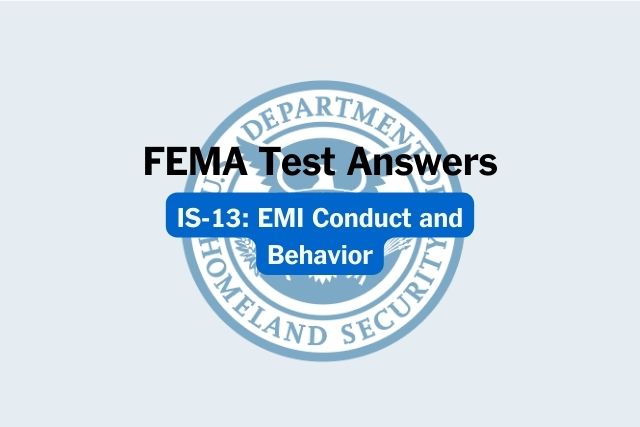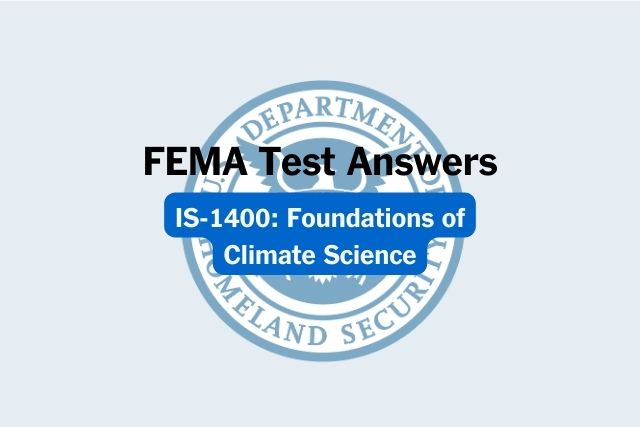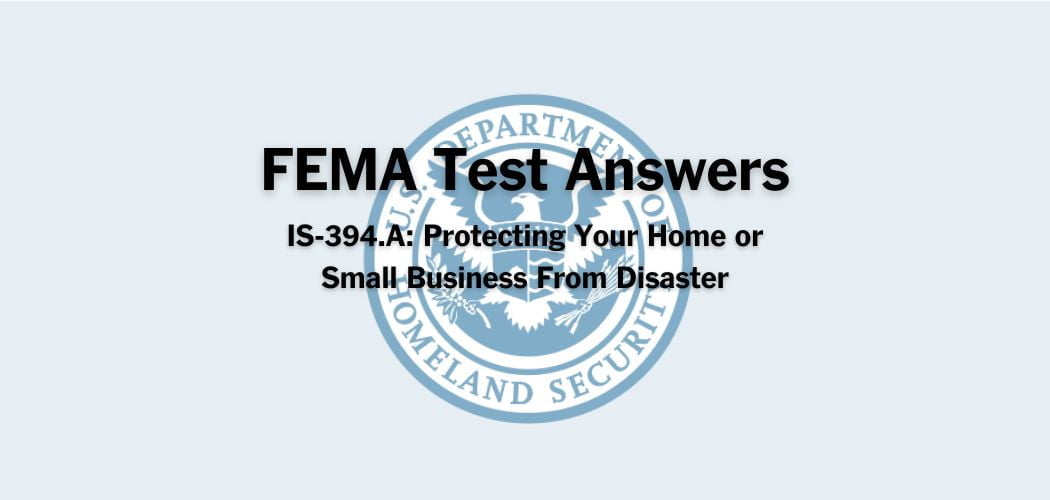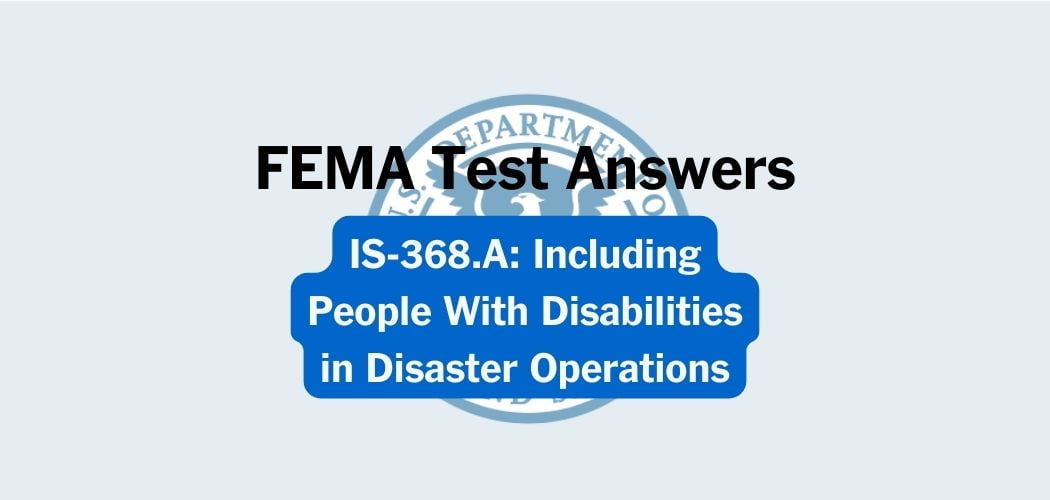Overview: The FEMA IS-802.A course was published on Apr 1, 2024 to describe the overall purpose and scope of ESF #2. This course also describes the roles and responsibilities of the ESF #2 coordinator, primary agencies, and support agencies during an incident.
Primary audience: FEMA IS-802.A is intended for anyone in the emergency management community. Ideally, participants have a baseline knowledge of incident management and have taken related courses through the EMI.
FEMA IS-802.A test answers
Note: Each time this test is loaded, you will receive a unique set of questions and answers. The test questions are scrambled to protect the integrity of the exam.
Question 1. Which resource would you access for more information about the ESF community as a whole?
A. The National Response Framework (NRF)✅
B. Presidential Policy Directive (PPD) 40
C. The Incident Action Plan (IAP)
D. The Stafford Act
Question 2. What is the process by which military assets and personnel can be used to assist in missions normally carried out by civil authorities during an ESF #2 activation?
A. Federal Request for Assistance (FRFA)
B. Defense Support of Civil Authorities (DSCA)✅
C. Defense Coordination Act (DCA)
D. Military Augmentation Response Corps (MARC)
E. Disaster Information Reporting System (DIRS)
Question 3. Critical infrastructure facilities such as utilities and hospitals are which partner’s responsibility?
A. Local government
B. Private sector✅
C. State government
D. Federal government
Question 4. As a primary agency, this entity develops ESF #2 documentation, policies, and procedures.
A. Cybersecurity and Infrastructure Security Agency (CISA)✅
B. Department of Agriculture
C. Department of Commerce
D. Department of Defense (DoD)
E. Military Augmentation Response Cadre (MARC)
Question 5. Who serves as the coordinator for ESF #2?
A. Federal Emergency Management Agency (FEMA)
B. Cybersecurity and Infrastructure Security Agency (CISA)✅
C. Department of Defense (DoD)
D. Military Augmentation Response Cadre (MARC)
Question 6. Which of the following is NOT a support agency for ESF #2?
A. General Services Administration (GSA)
B. United States Postal Service (USPS)
C. Department of Defense (DoD)
D. Department of Commerce✅
E. Federal Communications Commission (FCC)
Question 7. Which of the following best describes the overall purpose of ESF #2?
A. To coordinate life-sustaining resources, essential services, and statutory programs when the needs of disaster survivors exceed SLTT government capabilities.
B. To collect, analyze, process, and disseminate information about a potential or actual incident, and conduct deliberate and crisis action planning activities to facilitate assistance to the whole community.
C. To assist SLTT governments, non-governmental organizations (NGOs), and the private sector by coordinating government capabilities, services, technical assistance, and engineering expertise during incidents.
D. To support the restoration of communications infrastructure, coordinate communications support to response efforts, facilitate the delivery of information, and assist in the stabilization and reestablishment of systems and applications during incidents.✅
Question 8. In which entity is the ESF #2 team located at CISA?
A. Cybersecurity Division (CSD)
B. Stakeholder Engagement Division (SED)
C. Integrated Operations Division (IOD)✅
D. Division of Strategy, Policy, & Plans (DSPP)
Question 9. Which of the following describes the role and responsibilities of the Military Augmentee Response Cadre (MARC)?
A. Provides communications support to NSSE events such as presidential inaugurations and the Super Bowl.
B. Established in 2001 to provide a cadre of active duty military members to assist in national emergencies.
C. Activated through a formal request process between FEMA and the Department of Defense.✅
D. Coordinates with FEMA to activate Federal ESF #2 under the Stafford Act.
Question 10. How are the ESF annexes organized?
A. By event type
B. By functional area✅
C. According to the Community Lifelines
D. In alignment with the Core Capabilities
Question 11. Which of the following deployment actions is NOT a part of ESF #2?
A. Deploy to the Federal Communications Commission (FCC).✅
B. Deploy to a Joint Field Office (JFO) to support the Comms Unit in the Information and Communications Technology (ICT) Branch.
C. Deploy to an RRCC to coordinate regional activities.
D. Deploy to the NRCC to staff the ECUL Desk.
Question 12. Which entity manages the oversight of an ESF?
A. The Primary Agency
B. The Executive Agency
C. The Support Agency
D. The Coordinating Agency✅
Question 13. When ESF #2 is activated, which agency coordinates Federal telecommunications assistance to SLTT governments?
A. Department of Commerce
B. General Services Administration (GSA)
C. Federal Communications Commission (FCC)✅
D. Department of Agriculture
Question 14. What is one way private sector groups and Non-Governmental Organizations (NGOs) support ESF #2?
A. Maintaining the National Security and Emergency Preparedness (NS/EP) system.
B. Overseeing the Integrated Public Alert & Warning System (IPAWS).
C. Providing critical information and facilitate the sharing of resources to support response.✅
D. Coordinating and deconflicting incident radio frequencies within affected areas of operation.
Question 15. Which of the following is NOT a method by which ESF #2 provides support to SLTTs?
A. Provides communications support to SLTT first responders.
B. Provides information and technical expertise to assist public safety answering points (911) and telecommunications infrastructure in communications stabilization.
C. Directs the military to assist with law enforcement activities in response efforts related to natural and man-made disasters.✅
D. Provides short-term restoration support SLTT and insular area government emergency communications.



